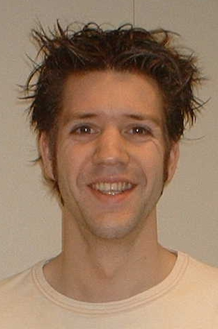Nanochannel fabrication and characterization using bond micromachining
Promotion Date: 20 January 2006
| In short we tried to develop new techniques to make nanochannels, tiny channels for fluids or gases, and making them as cheap, accurate and robust as possible. We applied two methods, one is wet etching in silicon, which itself has a nice ordered structure resulting in a very tidy square channel. The other technology we used was the application of a spacer layer on a silicon wafer that determines the depth of the actual nanochannel. In fact we used standard micromachining techniques to make nanostructures in one wafer and created a channel by bonding it to another wafer. |
What was your thesis about?
In short we tried to develop new techniques to make nanochannels, tiny channels for fluids or gases, and making them as cheap, accurate and robust as possible. We applied two methods, one is wet etching in silicon, which itself has a nice ordered structure resulting in a very tidy square channel.
The other technology we used was the application of a spacer layer on a silicon wafer that determines the depth of the actual nanochannel. In fact we used standard micromachining techniques to make nanostructures in one wafer and created a channel by bonding it to another wafer.
You did this to facilitate your co-researchers in the field of nanotechnology?
Yes, you could put it that way. In fact, if with my thesis in their hand, researchers with some familiarity of clean room can make their own nanostructures quickly and accurately, within half a day I would say. My thesis is a kind of a recipe book. And the result is better than before.
Does somebody working in the field of nanotechnology always need a channel or similar structure?
Yes, that is often the case. If you check the literature, you’d find that they already made this kind of channel by using dry etching techniques. But it was much less accurate than my channels, which is important at these very small dimensions.
So the wet etching is a completely new technique?
Yes and no. The actual etchant is TMAH, a commonly used chemical for wet anisotropic etching of silicon. However, we used an etching solution which also contains some additives, resulting in a very smooth surface.
This is really an improvement for everybody working in the clean room.
Can your channels be used for very application in the field of nanotechnology?
They can be deployed in quite a few areas. DNA analysis and separation is a hot topic these days. In this field this kind of channel is often used. Also in electro osmotic flow devices these channels are applied. All interesting phenomena in this kind of device occur very close to the sides of the channel. My channels are very well suited for this.
How are you going to spread the word?
Of course here at the University there is a lot of direct exchange of information between the researchers. Furthermore it is everybody’s own responsibility to check the literature. We published the results in the Journal of Micromechanics and Microengineering and in Applied Physics Letters, and one publication is soon to follow in Nano Letters. I have noticed that the first article I published on wet etching is quite frequently referred to.
What did you like best about your research?
I had a lot of freedom to work it all out by myself. I liked that. We deviated quite a bit from the original project proposal because it took a lot of time getting a piece of equipment in working order. Technology development is very much a thing of actually getting things done.
And what didn’t you like?
I couldn’t say. On the whole I enjoyed myself very much. Beyond the reasonable setbacks that always occur when doing research there has never been a serious problem.
What are you going to do next?
There is a very good chance that I will stay here at this University, working on a project involving Micro Coriolis flow sensors, which can be used to measure the mass flow of a fluid, independent of for instance the flow profile, temperature and pressure of the liquid. It seems like a very nice project, something completely different for me, with a working device as the final goal.
For the summary of the thesis, click here.

